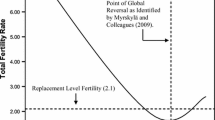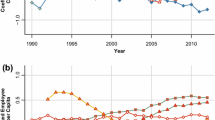Abstract
Many scholars have offered structural and ideational explanations for the fertility changes occurring around the world. This paper focuses on the influence of developmental idealism—a schema or set of beliefs endorsing development, fertility change, and causal connections between development and fertility. Developmental idealism is argued to be an important force affecting both population policy and the fertility behavior of ordinary people. We present new survey data from ordinary people in six countries—Argentina, China, Egypt, Iran, Nepal, and the United States—about the extent to which developmental idealism is known and believed. We ask individuals if they believe that fertility and development are correlated, that development is a causal force in changing fertility levels, and that fertility declines enhance the standard of living and intergenerational relations. We also ask people about their expectations concerning future trends in fertility in their countries and whether they approve or disapprove of the trends they expect. The data show widespread linkage in the minds of ordinary people between fertility and development. Large fractions of people in these six settings believe that fertility and development are correlated, that development reduces fertility, and that declines in fertility foster development. Many also expect and endorse future declines in fertility.
Similar content being viewed by others
Notes
Many scholars have argued that elements of developmental idealism, which here are proposed to have their roots in Western philosophy, have their roots in non-Western thought (see Yount and Rashad 2008). Identifying the origins of these ideas in non-Western thought is argued to have fostered their popular acceptance in some settings.
In Nepal, the question asked respondents to compare traditional versus developed places.
In Nepal, we asked about the expected consequences of Nepal itself becoming richer rather than referring to a hypothetical low-income, rural country.
In Nepal, we asked about the “future of wealth” rather than “standard of living,” and about “respect for parents or in-laws” rather than “respect for elders.”
References
Abbasi-Shavazi, M. J., & McDonald, P. (2006). The fertility decline in the Islamic Republic of Iran, 1972–2000. Asian Population Studies, 2, 217–237.
Abbasi-Shavazi, M. J., McDonald, P., & Hosseini-Chavoshi, M. (2009). The fertility transition in Iran: Revolution and reproduction. New York: Springer.
Ali, K. A. (1997). Modernization and family planning programs in Egypt. Middle East Report, 27(4), 4–40.
Askari-Nodoushan, A., & Abbasi-Shavazi, M. J. (2009, Sept.–Oct.). Intergenerational variation and changes in attitudes towards marriage issues in Iran (Discussion Paper). XXVI IUSSP International Population Conference, Marrakech, Morocco.
Barrett, D., & Frank, D. J. (1999). Population control for national development: From world discourse to national policies. In J. Boli & G. M. Thomas (Eds.), Constructing world culture: International nongovernmental organizations since 1875 (pp. 198–221). Stanford, CA: Stanford University Press.
Bier, L. (2008). From birth control to family planning: Population, gender, and the politics of reproduction in Egypt. In K. M. Yount & H. Rashad (Eds.), Family in the Middle East: Ideational change in Egypt, Iran, and Tunisia (pp. 55–79). New York: Routledge.
Carr-Saunders, A. M. (1936). World population: Past growth and present trends. Oxford, UK: Clarendon Press.
Chow, G. C. (2007). China’s economic transformation (2nd ed.). Oxford, UK: Wiley-Blackwell.
Critchlow, D. T. (1999). Intended consequences: Birth control, abortion, and the federal government in modern America. New York: Oxford University Press.
D’Andrade, R. G. (1984). Cultural meaning systems. In R. A. Shweder & R. LeVine (Eds.), Culture theory: Essays on mind, self, and emotion (pp. 88–119). Cambridge, UK: Cambridge University Press.
Donaldson, P. J. (1990). Nature against us: The United States and the world population crisis, 1965–1980. Chapel Hill: University of North Carolina Press.
El-Zanaty, F., & Way, A. (2006). Egypt demographic and health survey 2005. Ministry of Health and Population, National Population Council. Cairo, Egypt: El-Zanaty and Associates and ORC Macro.
Fricke, T. (1997). The uses of culture in demographic research: A continuing place for community studies. Population and Development Review, 23, 825–832.
Geertz, C. (1973). The interpretation of cultures. New York: Basic.
Gordon, D. (1994). Citizens without sovereignty. Princeton, NJ: Princeton University Press.
Greenhalgh, S. (2008). Just one child: Science and policy in Deng’s China. Berkeley, CA: UC Press.
Guo, Z., & Chen, W. (2007). Below replacement fertility in mainland China. In Z. Zhao & F. Guo (Eds.), Transition and challenge: China’s population at the beginning of the 21st century (pp. 54–70). Oxford, UK: Oxford University Press.
Harkavy, O. (1995). Curbing population growth: An insider’s perspective on the population movement. New York: Plenum Press.
Harris, M. (1968). The rise of anthropological theory. New York: Thomas Y. Crowell Company.
Hodgson, D. (1983). Demography as social science and policy science. Population and Development Review, 9, 1–34.
Hodgson, D. (1988). Orthodoxy and revisionism in American demography. Population and Development Review, 14, 541–569.
Hodgson, D., & Watkins, S. C. (1997). Feminists and neo-Malthusians: Past and present alliances. Population and Development Review, 23, 469–524.
Hume, D. (1825). Essays and treatises. Edinburgh, UK: James Walker. (Original work published 1742)
International Telecommunication Union. (2010). ICT statistics database. Retrieved from http://www.itu.int/ITU-D/icteye/Indicators/Indicators.aspx
Johnson, S. P. (1994). World population—Turning the tide: Three decades of progress. London, UK: Graham & Trotman/Martinus Nijhoff.
Johnson-Hanks, J. A., Bachrach, C. A., Morgan, S. P., & Kohler, H.-P. (2011). Understanding family change and variation: Toward a theory of conjunctural action. New York: Springer.
Keely, C. B. (1994). Limits to papal power: Vatican inaction after humanae vitae. In J. L. Finkle & C. A. McIntosh (Eds.), The new politics of population: Conflict and consensus in family planning (pp. 220–240). New York: The Population Council.
Lavely, W., & Freedman, R. (1990). The origins of the Chinese fertility decline. Demography, 27, 357–367.
Lesthaeghe, R. (1977). The decline of Belgian fertility, 1800–1970. Princeton, NJ: Princeton University Press.
Lesthaeghe, R., & Wilson, C. (1986). Modes of production, secularization, and the pace of fertility decline in Western Europe, 1870–1930. In A. J. Coale & S. C. Watkins (Eds.), The decline of fertility in Europe (pp. 261–292). Princeton, NJ: Princeton University Press.
Malthus, T. R. (1986). An essay on the principle of population. In E. A. Wrigley & D. Souden (Eds.), The works of Thomas Robert Malthus. London, UK: William Pickering. (Original work published in 1803)
Mandelbaum, M. (1971). History, man, and reason: A study in nineteenth-century thought. Baltimore, MD: The Johns Hopkins Press.
Meyer, J. W., Boli, J., Thomas, G. M., & Ramirez, F. O. (1997). World society and the nation-state. The American Journal of Sociology, 103, 144–181.
Ministry of Health and Population (MOHP) [Nepal], New ERA, and Macro International Inc. (2007). Nepal demographic and health survey 2006. Kathmandu, Nepal: Ministry of Health and Population, New ERA, and Macro International Inc.
Mita, R., & Simmons, R. (1995). Diffusion of the culture of contraception: Program effects on young women in rural Bangladesh. Studies in Family Planning, 26, 1–13.
Nisbet, R. A. (1975). Social change and history. New York: Oxford University Press. (Original work published 1969)
Nisbet, R. A. (1980). History of the idea of progress. New York: Basic Books.
Nortman, D. L. (1985). Population and family planning programs: A compendium of data through 1983 (12th ed.). New York: Population Council.
Pantelides, E. A. (2006). La transición de la fecundidad 1869–1947 [Fertility transition 1869–1947]. Buenos Aires, Argentina: Centro de Estudios de Población (CENEP), Cuaderno del CENEP N 54.
Phillips, J. F., Hossain, M. B., Simmons, R., & Koenig, M. A. (1993). Worker-client exchanges and contraceptive use in rural Bangladesh. Studies in Family Planning, 24, 329–342.
Pollard, L. (2003). The promise of things to come: The image of the modern family in state building, colonial occupation, and revolution in Egypt 1805–1922. In L. Haney & L. Pollard (Eds.), Families of a new world: Gender, politics, and state development in a global context (pp. 17–39). New York: Routledge.
Population Reference Bureau (2007). World population highlights. Population Bulletin, 62(3).
Ross, E. A. (1927). Standing room only. New York: The Century Co.
Sanderson, S. K. (1990). Social evolutionism. A critical history. Oxford, UK: Basil Blackwell.
Swindlehurst, A. (1916). Some phases of the law of marriage. Harvard Law Review, 30, 124–140.
Szreter, S. (1993). The idea of demographic transition and the study of fertility change. Population and Development Review, 19, 659–702.
Thomas, G. M., Meyer, J. W., Ramirez, F. O., & Boli, J. (1987). Institutional structure: Constituting state, society, and the individual. Newbury Park, CA: Sage Publications.
Thompson, W. S. (1930). Population problems. New York: McGraw-Hill Book Company, Inc.
Thornton, A. (2001). The developmental paradigm, reading history sideways, and family change. Demography, 38, 449–465.
Thornton, A. (2005). Reading history sideways: The fallacy and enduring impact of the developmental paradigm on family life. Chicago, IL: University of Chicago Press.
Tilly, C. (1978). Historical studies of changing fertility. Princeton, NJ: Princeton University Press.
Tilly, C. (1984). Big structures, large processes, huge comparisons. New York: Russell Sage Foundation.
United Nations, Development of Economic and Social Affairs, Population Division. (2009). World Population 2008 (Wall chart; United Nations Publication Sales No. E.09.XIII.2). New York: United Nations.
United Nations Development Programme (UNDP). (2009). Human development report 2009. New York: UNDP.
Watkins, S. (2000). Local and foreign models of reproduction in Nyanza Province, Kenya. Population and Development Review, 26, 725–759.
Yount, K. M., & Rashad, H. (2008). Family in the Middle East: Ideational change in Egypt, Iran, and Tunisia. Oxford, UK: Routledge.
Yount, K. M., Thornton, A., Mehanna, S., Patel, S., & Moaddel, M. (2010, May). Lay perceptions of “traditional” and “modern” family in greater Cairo. Paper presented at Workshop on Methodological and Theoretical Issues in the Study of Values in Islamic Countries, Cairo, Egypt.
Acknowledgments
This work was supported by grants from the National Institute of Child Health and Human Development (R37-HD-039425, R21-HD-050-259), the Michigan Center for the Demography of Aging, The Alfred P. Sloan Foundation through the Emory University Center for Myth and Ritual in American Family Life, the Population Studies Center of the University of Michigan, and the Survey Methodology Program of the University of Michigan. An earlier version of this paper was presented at the “Special Interdisciplinary Workshop on Fertility Declines in the Past, Present and Future: What We Don’t Know and What We Need to Know,” sponsored by the British Society for Population Studies and Cambridge Group for the History of Population and Social Structure, Cambridge, England, July 2009. The paper was also presented at the annual meetings of the Population Association of America, Dallas, Texas, April 2010; a seminar at the Demographic Research Institute, Budapest, Hungary, August 2010; the meetings of the European Association of Population Studies, Vienna, Austria, September 2010; and the meetings of the Asian Population Association, Delhi, India, November 2010. We appreciate the comments of the discussants and participants at these presentations, as well as those from members of the Developmental Idealism Studies Group at various stages of this work. We also appreciate the input of the journal reviewers. We thank Abbas Askari Nodoushan and Bao Xiaoxia for their input into the data collection; Claudia Stilman for her work in the analysis of the data and in the preparation of the tables; and Judy Baughn, Jana Bruce, and Amanda Schuetz for administrative support and preparation of the manuscript. We also appreciate the contributions by the interviewers and respondents in the surveys that provide the data we report. Errors of omission and commission rest with the authors.
Author information
Authors and Affiliations
Corresponding author
Electronic Supplementary Material
Below is the link to the electronic supplementary material.
ESM 1
(PDF 731 kb)
Rights and permissions
About this article
Cite this article
Thornton, A., Binstock, G., Yount, K.M. et al. International Fertility Change: New Data and Insights From the Developmental Idealism Framework. Demography 49, 677–698 (2012). https://doi.org/10.1007/s13524-012-0097-9
Published:
Issue Date:
DOI: https://doi.org/10.1007/s13524-012-0097-9




